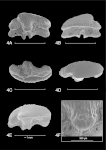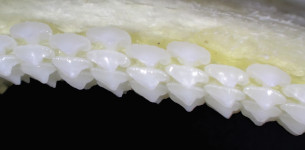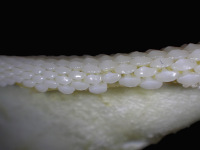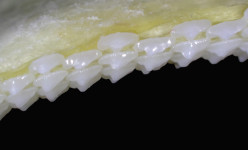Mustelus punctulatus
Risso, 1827
Blackspotted smooth-hound
Classification: Elasmobranchii Carcharhiniformes Triakidae
Reference of the original description
Histoire naturelle des principales productions de l'Europe méridionale et particulièrement de celles des environs de Nice et des Alpes-maritimes. F.G Levrault, Paris. Vol. 3, 480 pp
Histoire naturelle des principales productions de l'Europe méridionale et particulièrement de celles des environs de Nice et des Alpes-maritimes. F.G Levrault, Paris. Vol. 3, 480 pp
Synonyms / new combinations and misspellings
Galeorhinus punctulatus, Holohalaelurus punctulatus, Mustellus punctulatus, Mustelus aff. punctulatus, Mustelus mediterraneus
Galeorhinus punctulatus, Holohalaelurus punctulatus, Mustellus punctulatus, Mustelus aff. punctulatus, Mustelus mediterraneus
Description :
Citation: Mustelus punctulatus Risso, 1827: In: Database of modern sharks, rays and chimaeras, www.shark-references.com, World Wide Web electronic publication, Version 12/2025
Please send your images of "Mustelus punctulatus" to info@shark-references.com
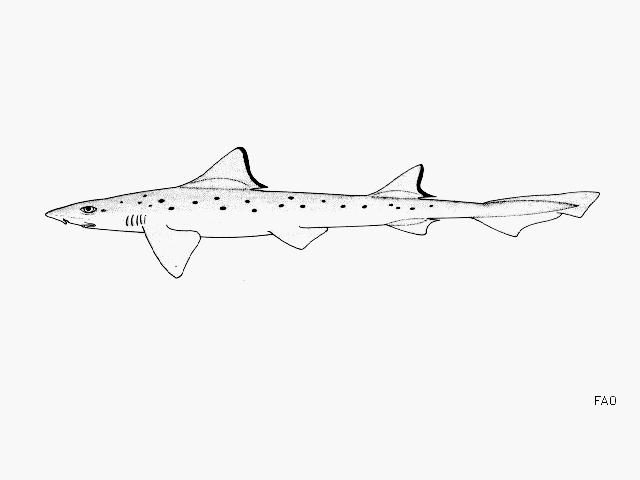
Dasyatis pastinaca Risso, 1827, © FAO, www.fish-base.org

Dasyatis pastinaca Risso, 1827, © FAO, www.fish-base.org
Common names
 Gepunkteter Glatthai,
Gepunkteter Glatthai,  Musola pimienta,
Musola pimienta,  Musola punteada,
Musola punteada,  Emissole pointilée,
Emissole pointilée,  Black spotted smooth hound,
Black spotted smooth hound,  Blackspot smooth hound,
Blackspot smooth hound,  Blackspotted smooth-hound,
Blackspotted smooth-hound,  Palombo punteggiato
Palombo punteggiato
 Gepunkteter Glatthai,
Gepunkteter Glatthai,  Musola pimienta,
Musola pimienta,  Musola punteada,
Musola punteada,  Emissole pointilée,
Emissole pointilée,  Black spotted smooth hound,
Black spotted smooth hound,  Blackspot smooth hound,
Blackspot smooth hound,  Blackspotted smooth-hound,
Blackspotted smooth-hound,  Palombo punteggiato
Palombo punteggiato
Short Description
Diagnosis after Compagno, 1984 [517]: Body fairly slender. Head short, prepectoral length 17 to 20% of total length; snout moderately long and bluntly angular in lateral view, preoral snout 5.6 to 7.5% of total length, preorbital snout 6.1 to 7.3% of total length; internarial space narrow, 1.9 to 2.3% of total length; eyes fairly large, eye length 2.1 to 2.8 times in preorbital snout and 2.3 to 3.6% of total length; interorbital space, 3.7 to 4.4% of total length; mouth short, subequal to eye length and 2 to 3.1% of total length; upper labial furrows definitely longer than lowers and 1.7 to 2.2% of total length; teeth molariform and asymmetric, with cusp reduced to a low point; distal cusplets absent except in very young sharks; buccopharyngeal denticles confined to tongue and anterior third of palate. Interdorsal space 18 to 22% of total length; trailing edges of dorsal fins naked, with a prominent band of dark, bare ceratotrichia; first dorsal broadly triangular, with posteroventrally sloping posterior margin, its midbase closer to pelvic bases than to pectorals; pectoral fins fairly small, anterior margin lengths 12 to 14% of total length, width of posterior margins 7.2 to 11% of total length; pelvic fins small, anterior margin length 7.4 to 8.8% of total length; anal height 2.3 to 3.4% of total length; anal-caudal space greater than second dorsal height, and 6 to 8.2% of total length; ventral caudal lobe falcate in adults. Crowns of lateral trunk denticles lanceolate, with or without weak ridges that, when present, extend at most only half their length. Cranium, hyomandibulae, and scapulocoracoids not hypercalcified in adults; palatoquadrates not subdivided; monospondylous precaudal centra 32 to 37, diplospondylous precaudal centra 41 to 50, precaudal centra 78 to 84. Colour uniform grey or grey-brown above, light below, often with small black spots but without white or dark bars. Development uncertain. Size moderate, adults 50 to 90 cm.
Diagnosis after Compagno, 1984 [517]: Body fairly slender. Head short, prepectoral length 17 to 20% of total length; snout moderately long and bluntly angular in lateral view, preoral snout 5.6 to 7.5% of total length, preorbital snout 6.1 to 7.3% of total length; internarial space narrow, 1.9 to 2.3% of total length; eyes fairly large, eye length 2.1 to 2.8 times in preorbital snout and 2.3 to 3.6% of total length; interorbital space, 3.7 to 4.4% of total length; mouth short, subequal to eye length and 2 to 3.1% of total length; upper labial furrows definitely longer than lowers and 1.7 to 2.2% of total length; teeth molariform and asymmetric, with cusp reduced to a low point; distal cusplets absent except in very young sharks; buccopharyngeal denticles confined to tongue and anterior third of palate. Interdorsal space 18 to 22% of total length; trailing edges of dorsal fins naked, with a prominent band of dark, bare ceratotrichia; first dorsal broadly triangular, with posteroventrally sloping posterior margin, its midbase closer to pelvic bases than to pectorals; pectoral fins fairly small, anterior margin lengths 12 to 14% of total length, width of posterior margins 7.2 to 11% of total length; pelvic fins small, anterior margin length 7.4 to 8.8% of total length; anal height 2.3 to 3.4% of total length; anal-caudal space greater than second dorsal height, and 6 to 8.2% of total length; ventral caudal lobe falcate in adults. Crowns of lateral trunk denticles lanceolate, with or without weak ridges that, when present, extend at most only half their length. Cranium, hyomandibulae, and scapulocoracoids not hypercalcified in adults; palatoquadrates not subdivided; monospondylous precaudal centra 32 to 37, diplospondylous precaudal centra 41 to 50, precaudal centra 78 to 84. Colour uniform grey or grey-brown above, light below, often with small black spots but without white or dark bars. Development uncertain. Size moderate, adults 50 to 90 cm.
Distribution
Eastern Atlantic: Mediterranean to Western Sahara. Confused with Mustelus mustelus and most data for this species were in part attributable to Mustelus mediterraneus. Source: www.gbif.org
Eastern Atlantic: Mediterranean to Western Sahara. Confused with Mustelus mustelus and most data for this species were in part attributable to Mustelus mediterraneus. Source: www.gbif.org
Human uses
fisheries: commercial
fisheries: commercial
Biology
Probably viviparous [517]. Distinct pairing with embrace [17086].
Diet: Gulf of Trieste (data base: 151 specimens): Crustaceanswere themost important prey items (IRI%= 56.14), whereas cephalopods were the second mostly preyed animals (IRI% = 20.2). Teleost fish and bivalves were also found in the stomachs. The most important prey species was Solecurtus strigillatus. Larger sharks consumed larger preys. Male and female sharks consumed similar food. Juvenile individuals consumed predominantly crustaceans, while cephalopods were more important in the diet of adult individuals. [14333];
Probably viviparous [517]. Distinct pairing with embrace [17086].
Diet: Gulf of Trieste (data base: 151 specimens): Crustaceanswere themost important prey items (IRI%= 56.14), whereas cephalopods were the second mostly preyed animals (IRI% = 20.2). Teleost fish and bivalves were also found in the stomachs. The most important prey species was Solecurtus strigillatus. Larger sharks consumed larger preys. Male and female sharks consumed similar food. Juvenile individuals consumed predominantly crustaceans, while cephalopods were more important in the diet of adult individuals. [14333];
Size / Weight / Age
190 cm TL (male/unsexed; (Ref. ))
190 cm TL (male/unsexed; (Ref. ))
Habitat
demersal; marine
demersal; marine
Remarks
shark-references Species-ID=3819;
shark-references Species-ID=3819;
Parasites (arranged by Jürgen Pollerspöck)
Monogenea
Cestoda
Trematoda
Nematoda
Copepoda
Isopoda
Monogenea
- Calicotyle palombi Euzet & Williams, 1960 [31118]
- Calicotyle stossichi Braun, 1899 [24384] [31118]
- Erpocotyle sp. [30559] [31118]
- Triloculotrema euzeti Boudaya & Neifar, 2016 [24900] [31118]
Cestoda
Trematoda
- Ptychogonimus megastomum (Rudolphi, 1819) [24384]
Nematoda
Copepoda
- Eudactylina insolens Scott & Scott, 1913 [16609]
- Kroyeria lineata Van Beneden, 1853 [16609]
- Lernaeopoda galei Krøyer, 1837 [16609] [27471] [30559]
- Nemesis robusta (Van Beneden, 1851) [16609]
- Nesippus orientalis Heller, 1868 [16609]
- Perissopus dentatus Steenstrup & Lütken, 1861 [16609]
Isopoda
- Ceratothoa oestroides (Risso, 1826) [30559]
- Ceratothoa parallela (Otto, 1828) [30559]
- Natatolana borealis (Lilljeborg, 1851) [29380]








